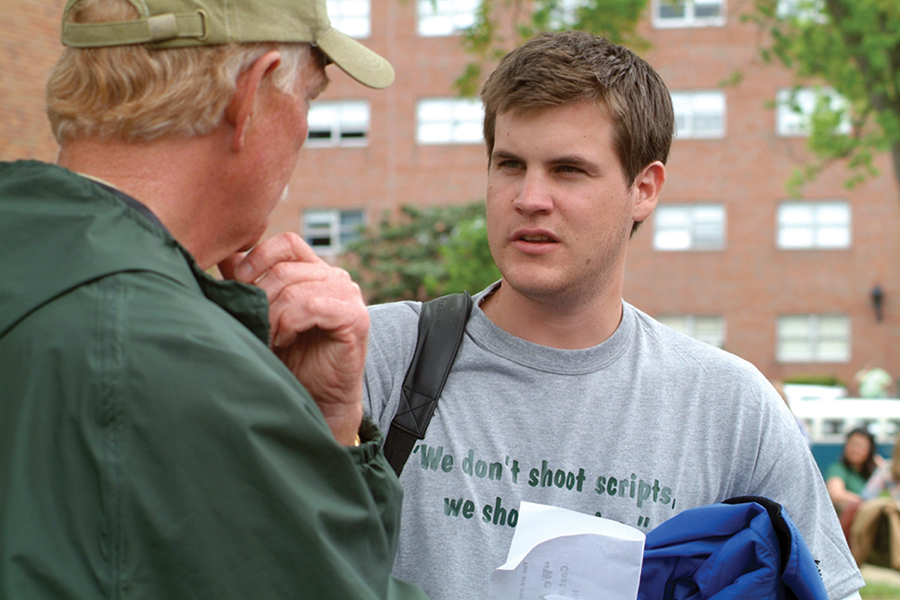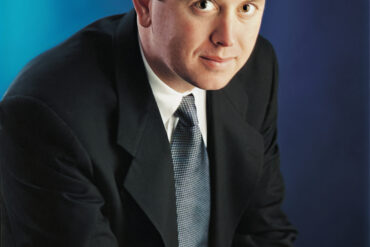What began as a script by a talented young writer has become the most eagerly anticipated event in the history of Huntington.
By Dave Wellman
HQ 60 | WINTER 2007
To most who know the history of the catastrophic Nov. 14, 1970 Marshall University plane crash, it seems only logical that it has become the subject of a major motion picture. But why now? What took so long for someone or some studio to commit to turning the amazing story of tragedy and triumph into a movie?
Why, more than 35 years later, did Warner Bros. Pictures decide the time is right to use the big screen to tell the world about the crash – the worst sports-related disaster in U.S. history? It is not as if no one before had thought of telling the story of the horrible event that claimed the lives of 75 people, including most of the Marshall football team, and the miraculous, emotional recovery of a university and community that followed.
“Each year since I came to the president’s office in 1997, I would get various and sundry telephone calls from would-be producers who would want to produce a movie about the Marshall plane crash,” Dr. H. Keith Spears, Marshall’s vice president for communications and marketing, said. “Every one was with good intentions, but typically lacked the resources and the ability to do it.”
The difference this time? A script.
In late summer 2005, Hollywood again came calling. This time the message was from Warner Bros. producer Basil Iwanyk, who had made up his mind to make a movie on the Marshall crash and wanted to talk with Spears about his plans.

“I thought quite frankly, ‘Oh boy, another one,’ ” Spears said, recalling his first reaction to the news that Iwanyk had called. Spears doubted that this proposal would be any different than previous ones. But Iwanyk’s proposal was different. He had a script for the movie already in hand.
“When he told me he had a script, I thought that was very significant,” Spears said. The script had been written by young Jamie Linden, a 2001 Florida State University alumnus who had learned about the crash while reading a story in the school newspaper a year before he graduated. He had been obsessed with the story since reading the article, and turned it into a screenplay that Warner Bros. bought in March 2004.
Spears, though not totally sold on the idea of a movie, listened with an open mind to what Iwanyk had to say. All the while, he remembered that the documentary Ashes to Glory had been released in 2000 on the 30th anniversary of the crash, and it won rave reviews and awards. He questioned whether a movie was even needed.
“We felt the documentary did a very good job of describing the intense emotion of what the community had gone through,” Spears said. “We didn’t think it was necessary to have a movie.”
At first, Spears turned down Iwanyk’s offer to visit Warner Bros. in California at the studio’s expense. Eventually, Iwanyk and Mary Viola, an associate producer with Thunder Road Pictures in Burbank, Calif., decided to fly cross-country to Huntington to visit Spears and the university. Viola, too, was “obsessed” with the Marshall story.

The two producers made it clear during that late-summer visit that they had been given great encouragement by Warner Bros. to produce the movie, whether Marshall was involved or not. “We knew that it is not imperative that the university be involved with a film about it,” Spears said.
But Warner Bros. wanted Marshall to be involved in the process. “We appreciate the fact that they came to us, asking us to be actively involved,” Spears said. By coincidence, another major studio got involved in negotiations with Marshall and its Board of Governors last fall, declaring its interest in making a movie on the crash. Suddenly, producers from two studios were in Huntington, talking at different times with the Board of Governors executive committee.
Menis Ketchum, chairman of the Board of Governors, expressed his concerns as talks between the studios and board began.
“Our main concern was whether a movie company would budget enough money to do the movie justice and to get it national attention,” he said. “We wanted enough money budgeted so that they could get the right movie stars, and cause a buzz across the country. We wanted to be sure the plane crash story would be told in a light favorable to the crash victims.”
Spears said the board had some “wide parameters” it wanted the producers to stay within. “One, honor those who were killed on the plane and their survivors,” Spears said. “Two, respect the citizens of Huntington and West Virginia, and our Appalachian culture; and three, guard the integrity of the university.”
The executive committee decided to cooperate with Warner Bros. and Warner Bros. decided to fund the entire project. In early November 2005, We Are Marshall, though untitled at the time, was on its way to becoming a reality.

In the next several weeks, producers, directors and actors were hired, and scouting for places to shoot was ongoing on Marshall’s campus and in the Huntington community. Through combined efforts of West Virginia Gov. Joe Manchin’s office, Pam Haynes of the West Virginia Film Office and Marshall, it was agreed that Warner Bros. would spend three weeks in spring 2006 filming in the community and on Marshall’s campus. The final two months, which would include the movie’s football scenes, would be filmed in Atlanta where Morris Brown College’s Herndon Stadium would be transformed into an old Fairfield Stadium look-alike.
Interest in the film ballooned when cast and crewmembers were publicized, one at a time. Matthew McConaughey, People Magazine’s “Sexiest Man Alive,” was chosen to play Jack Lengyel, coach of the Young Thundering Herd. Just like that, We Are Marshall had credibility. “It’s an honor to be stepping into his proverbial shoes,” McConaughey said of Lengyel. “What he did was some life affirming things.”
Another big name to join the crew, though not as widely known as McConaughey, was McG, who is directing the film. McG had directed Charlie’s Angels and Charlie’s Angels: Full Throttle. Even before he was announced as director of We Are Marshall, McG quietly visited Huntington, hanging out and talking to people to get their take on the crash and the recovery. That visit convinced him to shoot a good portion of the film in Huntington. “This is a tough little town,” he said later. “It’s the little town that wouldn’t quit.”

People from throughout the region and beyond wanted to be a part of the movie in one way or another. Most longed for a part as an extra. An open casting call for extras shortly before filming began attracted some 1,500 people to Marshall’s Joan C. Edwards Performing Arts Center. Others offered their old cars or their homes for use in the movie and some even wrote songs they hoped would be used in the film.
The movie attracted an impressive cast of stars, in addition to McConaughey. He was joined by Matthew Fox from ABC’s Lost, Oscar nominee David Strathairn and Ian McShane from Deadwood, among others. Finally, the shooting schedule was set. Filming would begin in Huntington on Monday, April 3, and continue for three weeks.
The city threw a huge block party on Saturday, April 1 to welcome the filmmakers to Huntington. The event, organized by Kindred Communications after Marshall originated the idea and city helped plan it, took place in front of the Keith-Albee Theatre on 4th Avenue and drew thousands of people. To their delight, McG and McConaughey greeted the shoulder-to-shoulder, camera-toting fans from a stage and joined in chilling shouts of “We Are … Marshall!”
Much of the filming that followed took place at several sites on Marshall’s campus, including the Morrow Library, Memorial Fountain, Campus Christian Center, Buskirk Field and the Memorial Student Center, to name a few. All were revamped by the set designer to look like 1970 all over again.
Downtown Huntington, too, was vintage 1970. The Keith-Albee marquee advertised “Kelly’s Heroes” as the featured attraction, storefronts were stocked with ’70s apparel and parking meters were painted gold like the old ones. Crowds gathered as close to the sets as possible not only to see the process unfold, but to perhaps get a glimpse of a movie star or two.

Throughout the pre-filming days, concerns surfaced as to how the story would be told. McG did his best to ease those worries during a pair of news conferences and other interviews with the media. “We want to get this story told properly and represent the community fairly and get the story out to the world,” he said.
Filming ended April 22 in Huntington then continued into June in Atlanta.
We Are Marshall will be released to the world on Dec. 22. Prior to that movie will have two premieres: one in Huntington on Dec. 12 and another in Hollywood on Dec. 14.
Marshall Stephen J. Kopp said he expects the film to project Marshall University in a very positive light.
“From what i have witnessed and in discussions with McG, I am very impressed with the professionalism and sensitivity bordering on reverence that has been shown for the story,” Kopp said.
It took decades for it to happen, but We Are Marshall is just days away from its worldwide release.
Thanks to a script.





